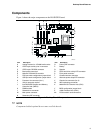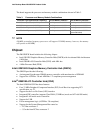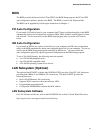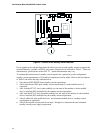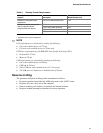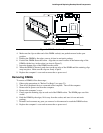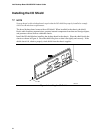
Desktop Board Features
17
Power Management Features
Power management is implemented at several levels, including:
• Software support:
Advanced Power Management (APM)
Advanced Configuration and Power Interface (ACPI)
• Hardware support:
Power connector
Fan connectors
Instantly Available technology ACPI S3 state (must be enabled in BIOS under the Power
menu)
S5 wake on PCI bus connector 2 only
Wake from USB (see page 35 for information on how to set the jumper blocks)
Wake from keyboard/mouse (see page 35 for information on how to set the jumper blocks)
Wake on PME
Resume on Ring
If the board is used with an ACPI-aware operating system, the BIOS can provide ACPI support.
Otherwise, it defaults to APM support.
Instantly Available Technology
CAUTION
For Instantly Available technology, the 5 V standby line for the power supply must be capable of
providing adequate +5 V standby current. Failure to provide adequate standby current when
using this feature can damage the power supply and/or affect ACPI S3 sleep state functionality.
CAUTION
If the standby current necessary to support multiple wake events from the PCI and/or USB buses
exceeds power supply capacity, the desktop board may lose register settings stored in memory.
Instantly Available technology enables the board to enter the ACPI S3 (Suspend-to-RAM) sleep
state. While in the S3 sleep state, the computer will appear to be off. When signaled by a wake-up
device or event, the system quickly returns to its last known awake state.
The board’s standby power indicator, shown in Figure 2, is lit when there is standby power to the
system. This includes the memory modules and PCI bus connectors even when the computer
appears to be off.
If the system has a dual-colored power LED on the front panel, the sleep state is indicated by the
LED turning amber.



